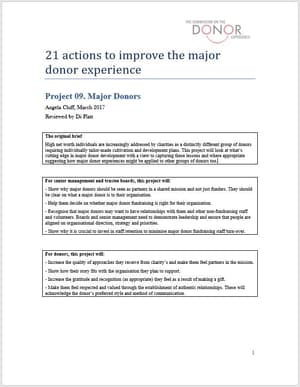CDE project 9: putting the principles and actions into practice — part 5
- Written by
- The Commission on the Donor Experience
- Added
- April 24, 2017
Making the relationship personal and authentic
Major donor fundraising succeeds when relationships are authentic and personal. Aspects of doing this successfully include:
- carefully matching staff members to donors and prospects. The staff member needs to see themselves as the donor’s representative in the organisation.
- responding to the donor’s preferred method and style of communication. For example, one donor might like meeting to talk face-to-face while another might prefer email. One donor might want require facts, while another might prefer emotive stories.
- treating the donor as you would a friend, but always remembering that as the fundraiser you are the face of the organisation’s relationship. It is your job to build the organisational relationship and make sure there are a range of touch points and contacts because one day you will not be there.
Here are some examples of successfully making it personal at different points in the solicitation process:
Make it personal – first approach
‘We cold contacted a prospect, not with a letter from the CEO or chair, but taking into account their background and their wife's background, with a piece of personalised artwork. Lots of charities had been targeting this prospect who was quite well known but ours stood out. As a result, this donor has made a major gift himself and helped us to raise over £1m from his contacts and endeavours.’
Alison Pemberton, Head of Philanthropy, NSPCC
Make it personal – cultivation
‘As an additional thank you we often send little gifts/mementos from stage productions - a script that has been used, a signed poster etc. I once sent a pair of shoe roses worn on stage to the donor of a production, which they adored. I also arranged for the same donor to send a gift to the acting company they were supporting. They were delighted when so many of the actors approached them saying thank you.
We often find it is the least expensive or obvious experiences that major donors most appreciate. An event in a rehearsal room with a plastic cup of barely chilled wine talking to a director and actor about their day or an evening spent backstage with stage management will always trump a sophisticated canape affair.’
Anonymous Development Director, national arts organisation
Make it personal – saying thank you
‘When I was Fundraising Director at Greenpeace USA a few years ago, we had a supporter who gave a huge amount of money in memory of her son, who had died tragically. With it, we bought a RIB – one of those orange inflatable boats Greenpeace is famous for. It was sent to join the Greenpeace ship Esperanza, which was on a mission to stop Japanese whalers in the Antarctic Southern Ocean. And the RIB was named the Billy G.[38]
As it happened, Celeste Stewart, the manager of our mid-donor programme, got the chance to join the Esperanza’s mission for three months as Assistant Cook. (I know, I know, don’t even ask). Celeste knew Billy G’s mother, knew the whole story. And even knew Billy G’s birthday, which came up while she was on board. She organised the crew into the Billy G for a photo. One photo, used only once, as a gift to Billy G’s mother to mark his birthday. Wow!’[39]
Matthew Sherrington, Consultant, Inspiring Action
Again, a very simple key message, but one that taken seriously can radically improve the donor experience.
---------------------
[38] Click on this link in the blog and you reach a beautiful donor-focused writeup of the story on Greenpeace International’s website http://www.greenpeace.org/inte...
[39] This is an extract from a longer blog published on 101fundraising http://101fundraising.org/2016...























